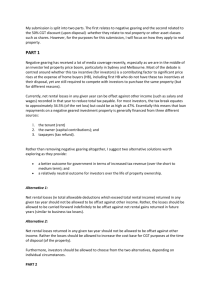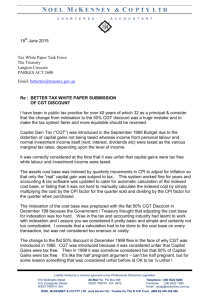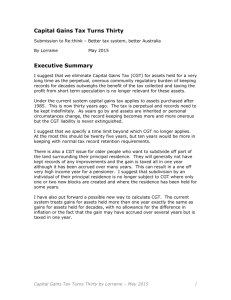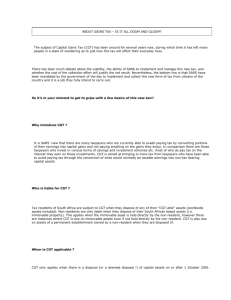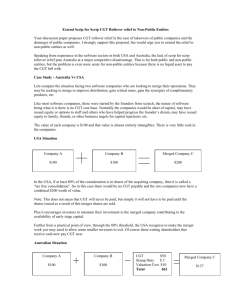capital gains tax
advertisement
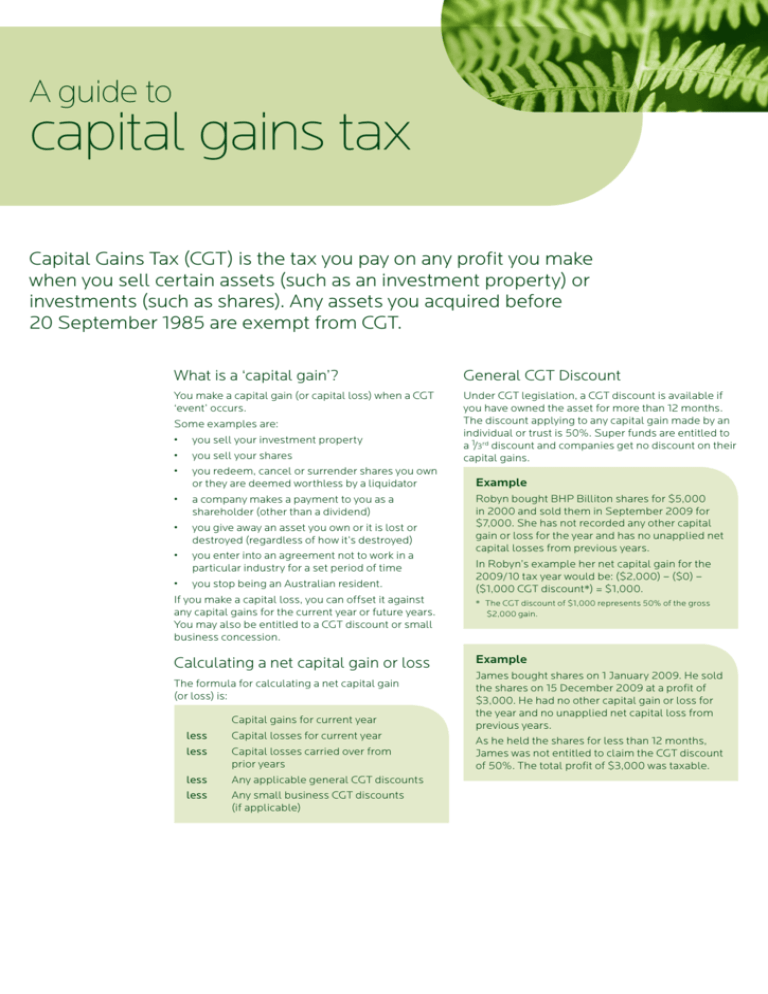
A guide to capital gains tax Capital Gains Tax (CGT) is the tax you pay on any profit you make when you sell certain assets (such as an investment property) or investments (such as shares). Any assets you acquired before 20 September 1985 are exempt from CGT. What is a ‘capital gain’? General CGT Discount You make a capital gain (or capital loss) when a CGT ‘event’ occurs. Some examples are: • you sell your investment property • you sell your shares • you redeem, cancel or surrender shares you own or they are deemed worthless by a liquidator • a company makes a payment to you as a shareholder (other than a dividend) • you give away an asset you own or it is lost or destroyed (regardless of how it’s destroyed) • you enter into an agreement not to work in a particular industry for a set period of time • you stop being an Australian resident. If you make a capital loss, you can offset it against any capital gains for the current year or future years. You may also be entitled to a CGT discount or small business concession. Under CGT legislation, a CGT discount is available if you have owned the asset for more than 12 months. The discount applying to any capital gain made by an individual or trust is 50%. Super funds are entitled to a 1/3rd discount and companies get no discount on their capital gains. Calculating a net capital gain or loss The formula for calculating a net capital gain (or loss) is: less less less less Capital gains for current year Capital losses for current year Capital losses carried over from prior years Any applicable general CGT discounts Any small business CGT discounts (if applicable) Example Robyn bought BHP Billiton shares for $5,000 in 2000 and sold them in September 2009 for $7,000. She has not recorded any other capital gain or loss for the year and has no unapplied net capital losses from previous years. In Robyn’s example her net capital gain for the 2009/10 tax year would be: ($2,000) – ($0) – ($1,000 CGT discount*) = $1,000. * The CGT discount of $1,000 represents 50% of the gross $2,000 gain. Example James bought shares on 1 January 2009. He sold the shares on 15 December 2009 at a profit of $3,000. He had no other capital gain or loss for the year and no unapplied net capital loss from previous years. As he held the shares for less than 12 months, James was not entitled to claim the CGT discount of 50%. The total profit of $3,000 was taxable. Discount method versus indexation method Capital Losses If you acquired assets between 20 September 1985 and 21 September 1999, you have the option of using the ‘indexation’ method to calculate the CGT payable. This method takes into account inflation and you only pay tax on the profit in excess of inflation. You would generally choose the option which results in less tax being paid. Example John owns a number of company shares that he purchased in July 1995 and has held for over 12 months. The shares have a cost base of $50,000, an indexed cost base of $52,466 (indexed up to 30 September 1999) and a current market value of $80,000. By selling the shares to his wife, John has two options to work out his capital gain/ loss amount for the shares: Indexation method ($) Discount method ($) Sale proceeds 80,000 80,000 Less indexed cost base 52,466 50,000 Gross capital gain 27,534 30,000 Less capital losses 0 0 Less CGT discount 0 15,000 27,534 15,000 Net capital gain A capital loss occurs if you sell an asset for less than you originally paid for it. If your total capital losses for the year are more than your total capital gains, you end up with a net capital loss for the year. Treatment of net capital gains or losses Your total net capital gains are included in your assessable income, added to any other assessable income you have and taxed at your marginal tax rate. If you have a net capital loss for the year, it does not reduce your current year taxable income (like a deduction would). However, you can carry forward capital losses to later income years, without time limits, and deduct them from future capital gains. Things you should consider This publication provides an overview or summary only and it shouldn’t be considered a comprehensive statement on any matter or relied upon as such. This publication doesn’t take into account your personal objectives, financial situation or needs. It’s important for you to consider these matters before making any financial decision and we recommend you seek help from a financial adviser. You should seek advice from a qualified taxation adviser when making any decisions about taxation matters. Important Information This information was prepared by Securitor Financial Group Ltd ABN 48 009 189 495 AFSL 240687. The information in this publication is current as at 17 December 2009. SE11073-0410bt In this case it is clearly better for John to use the discount method.
